I am a recent convert (extremely recent, to be honest, after my first and only encounter with the tiger at Ranthambhore last week) to wildlife love, but I have been a history nut for much much longer. Therefore, a holiday in Ranthambhore had to include a trip to the Ranthambhore fort from which the entire area derives its name. The fort, built sometime in the 10th century, stands on top of a hill, huge and forbidding and right in the heart of the protected park area. Ranthambhore is the second largest fort in Rajasthan, the first being Chittorgarh. As with all self-respecting forts, the climb up is steep and tiring, but the breath-taking views from the top more than make up for it. Apart from the tourists, the locals climb the fort with great ease quite regularly to visit the small Ganesh temple inside.
The guide we took with us rattled off names with practiced indifference – Hammir, Allaudin Khilji, Rann hill, Dulha Mahal… I listen only with half a ear, mostly engrossed in the distant views of the park and the colorful locals who run carelessly up and down the steps as we huff and puff our way up. We pass through the three main gates and past the small ganesh idol fashioned roughly with the hand where the old and the sick who cannot climb all the way up to the temple pay their respects to the god. My favorite moment of the entire trip to the fort was at the entrance of this tunnel where I stood looking at the sunlight pouring in from the other side, when this group of young Rajasthani women came laughing and half running into the tunnel, stopping short when they saw me with the camera, clicking away. hamara photu theek se kheencho – take our photographs properly, they ordered and stood neatly in a single file, stern “photo” looks on their face.
Our first stop is at the Dulha Mahal, now in ruins (as most of the fort is), a small terrace from which the breadth of the park is visible. Our guide points out deer grazing in the grass by the padam talao in the distance, and even baby crocs in the water, lying still as rocks. And then the Badal Mahal, open to the sky and clouds as the name suggests. A quick climb up a few steep and narrow steps and we are at the roof of the palace – and the entire park and the hills surrounding it stretch out in front of your eyes. The guide says with pride in his voice that the entire park turns green in the monsoons… tab yeh jagah swarg jaisa bann jaata hai – the place turns into heaven… I sit on the edge of the wall, my legs dangling in air, and imagine the place as it comes alive after the rains. Heaven indeed.
We then move ahead to the Ganesh temple at one end of the fort, where 500,000 pilgrims are said to congregate during the Ganesh festival every year. On the way to the temple, we spot several little blocks of stones piled up one on top of the other – it is believed that to successfully build a house (or anything else), it is essential to first build a small stone house somewhee near the temple. The temple itself is small and kitschy and interestingly has a small post box right in front – for the few families still living inside the fort. The area near the temple is very interesting to watch – friendly langurs ready to play with humans, gorgeous peacocks ready to run away at the slightest movement, cows that have somehow managed to reach this spot… and the pilgrims themselves. As with everywhere else in Rajasthan, there are people waiting with water to serve the thirsty.
It is already getting late as we walk to the chhatri mahal – the 32 pillared palace. We stand at the top of the palace and watch the sun set in the distance, disappearing in front of our eyes, painting the sky several shades of pink and red as it slowly sinks. There is lots more to the fort, including the gupt ganga, the perennial stream believed to originate straight from the Ganga. That side of the fort is also said to be good for spotting animals and birds, even the occasional leopard.
But it is beginning to get dark and we need to get out of the park soon. The walk down is never as tough as the climb up… and we are soon back at the base of the fort, where the jeep is waiting to take us back to our cool tents after a long hot day.
On Ranthambhore
The closest railway station to Ranthambhore is Sawai Madhopur, well connected from both Bombay and Delhi. We took the August Kranti Rajdhani from Bombay which stops at SM for a couple of minutes. All resorts and hotels are located on the road leading to the national park. There is accommodation to suit all needs and all budgets; we stayed in cozy tents at the Ranthambhore Bagh, which felt like home especially after the staff packed gajar ka halwa to take back with me on the train since we were not staying for dinner. Entry into the park is severely regulated and only 20 jeeps and 20 canters, all authorized by the government are allowed into the park at any safari. The Canter rides are far more comfortable than I had expected – and feared – but you need to make early bookings, easiest done through the hotel you stay with. The best time to visit Ranthambhore, if it is cool comfort you seek, is between November and February. However, the hot suimmer months are best for wildlife viewing and as our guide told us in a conspiratorial whisper – tab faltu ke loge nahi aatey hain – only the really serious brave the heat and go during that time. The park is shut from July till October for the rains.

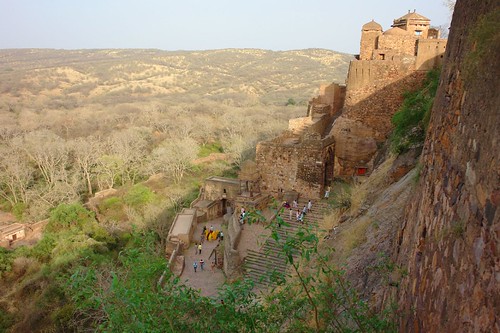
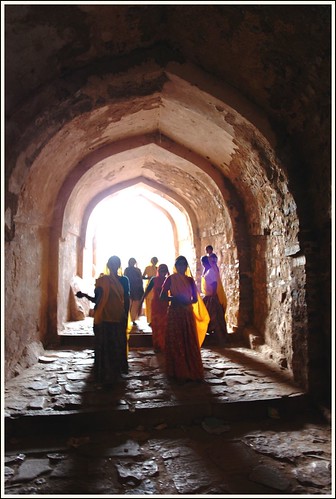
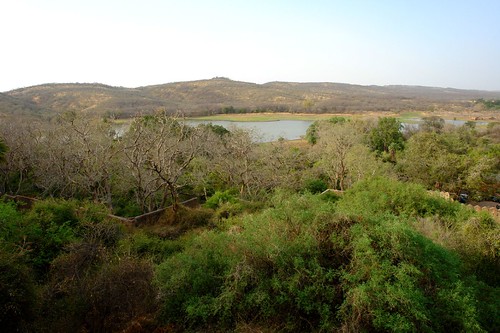
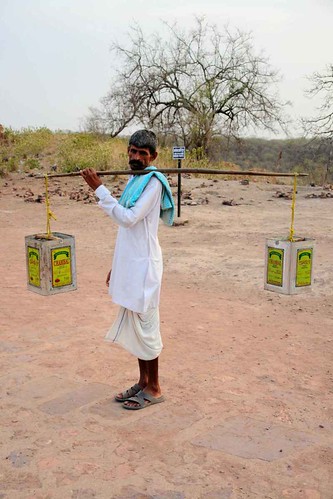
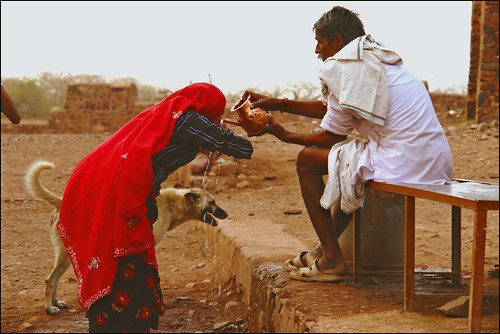
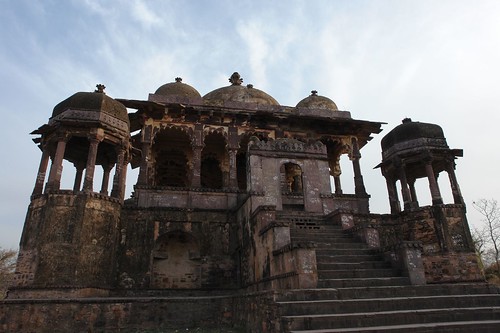



Very nice. I loved the bit about the “photo look” that these ladies put on for you. Also, interesting to note that the mark of the serious wildlife enthusiast is the discomfort that he/she is willing to put up with.
I quite like the picture of the man carrying two tins. What was in it?
Apu, thanks! the “photo look” is something I come across all the time – the minute people become conscious of you and your camera, they assume a straight seriosu pose, which is just what you don’t want!
Anil, thank you. He was carrying water…
You got some really beautiful pictures here! Thanks for sharing.